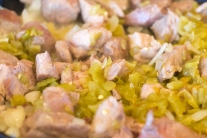Posole (po-so-lay) is decidedly Southwestern and maybe even uniquely Northern New Mexican, although it undoubtedly has some kinship to hominy from the American South. The word refers to at least wo different things.
First, it is one of the names used for nixtamalized corn. That’s dry corn treated with lye or an alkaline solution to remove the hard outer husk. It is a process that was developed by the peoples of the New World. You can read more about the process in one of my earlier posts about the history of corn. In other places, posole is called hominy.
Second, the word refers to a soup made with posole. In New Mexico the soup is popular during the Christmas-New Year holidays, but it is really a favorite during all the colder months of winter. For that matter, lots of people eat it all year long, sometimes instead of beans and rice. The soup has as many versions as there are cooks, but some things are constant: (1) posole, (2) chile (either red or green – you could probably even use both, (3) onions, (4) protein (chicken, pork, turkey – maybe even tofu and vegetarian), and (5) herbs and spices (cumin, cilantro, and Mexican oregano). Optional items include grated asadero or Monterrey jack cheese, sliced radishes, and diced avocado.
You can buy posole canned, frozen, partly cooked, and dry. For me the best version of the soup uses dry posole, but if you choose to use it you should be prepared for a long cooking time, much longer than described in most recipes.
Whatever version you choose, it is well worth the effort. For our family, it is a universal favorite that is required some time during a visit to Santa Fe. So here’s the recipe for pork green-chile posole.
RECIPE
Pork Green-Chile Posole
Ingredients
-
12 ounces dry posole
- water
- 2 tablespoons vegetable oil
- 1½ pounds boneless pork shoulder, cubed (If you’re feeling festive, you can substitute chops)
- 1 large yellow onion, chopped
- 7 ounces fresh-roasted, frozen, or canned New Mexico green chiles
- 3 tablespoons all-purpose flour
- 2 pints chicken stock
- 2 cloves garlic, pressed or chopped finely
- 1 teaspoon ground cumin
- 1 tablespoon dried Mexican oregano, crumbled in your hand
- salt and pepper to taste
- 2 cups grated asadero or Monterrey jack cheese (optional but highly recommended garnish)
- 2 cups chopped fresh cilantro leaves (optional but highly recommended garnish)
- 2 ripe avocados, peeled and diced (optional garnish)
- ½ cup thinly sliced radishes (optional)
- sour cream (optional)
Method
- Soak the dry posole over night in a large pot of water. Add more water if the posole absorbs it all.
- At least 6 hours before you plan to serve the soup, heat the oil over a medium-high flame in a large frying pan. Cast iron works well. Add the pork to the hot oil, being careful not to crowd it so you can get a good brown crust on the meat. Remove the browned meat to a plate with a slotted spoon. Lower the flame to medium-low. Then add the chopped onion. Add more oil if needed. Cover and let the onions sweat for about 5 minutes, stirring them occasionally. Do not let them brown. Add the green chiles and cook for an additional 2-3 minutes. Stir in the browned meat and pressed garlic. Add the flour and stir to completely coat the meat and vegetables. Cook for an additional 5 minutes to lose the flavor of uncooked flour.
- Drain the soaked posole into a large bowl, reserving some of the soaking liquid. Transfer the meat and vegetable mixture to the soaking pot, add the chicken stock and enough of the soaking water to cover. Bring the mixture to a boil, add the soaked posole, and adjust the liquid so that everything is completely covered.
- Add the cumin and crumbled Mexican oregano and reduce to the simmer. Adjust the seasoning with salt and pepper. Add water if necessary.
- Cook until the individual posole kernels are soft and “exploded” to resemble (a little bit) popcorn. They should have the consistency of al dente pasta.
- When the posole is done, serve it in large bowls. Pass bowls of cheese, cilantro, avocado, radishes, and sour cream for each guest to add to taste.
Notes:
- This recipe should serve 6 to 8 people
- If you think the soup is finished before you are ready to serve it, just turn down the heat or even re-heat it. Posole is one of those things that gets better with time.
- Some people prefer chicken. Use that instead if you wish. It is every bit as tasty.
- Piquancy is controlled by the heat of the chile. Food sensitivities in our family dictate mild, but you can always add your own hot sauce if you want your bowl to be spicier.
- Asadero is a Mexican cheese made with a process similar to that of mozzarella. If you can’t find it, mozzarella or Monterey jack will substitute perfectly.
- Mexican oregano often comes in a package of leaves, twigs, and flowers. That’s the kind you want. You should crumble the dried pieces between your hands to get the full flavor.


































